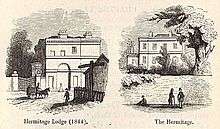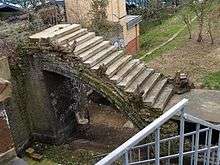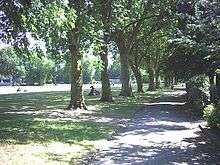Lillie Road
Lillie Road is a thoroughfare in the London Borough of Hammersmith and Fulham. It is a mixed residential and commercial road in the Postcode area of SW6.
It is also the A3218 road and runs east to west as the continuation of Old Brompton Road from Lillie Bridge (Fulham) to a T junction with the A219 road or Fulham Palace Road. Its main intersections are with the North End Road, Fulham and with the Munster Road at Fulham Cross.[1]
History

It is named after Sir John Scott Lillie, who first laid out the easternmost section of the road across his North End Hermitage estate in 1826 running from Gunter's footbridge over the tidal Counter's Creek to the T junction of the old Crown Lane with North End Lane.[2] The intention was to link traffic from the new Hammersmith Bridge with the North End wharves of the planned Kensington Canal, thus obviating passage through Hammersmith and Kensington, or following the entire loop of the Thames river to Chelsea.[3] Lillie's development also included late Georgian housing, terraces called, 'Rosa Villas' and 'Hermitage Cottages', on the north side of his 'New' road, some of which remain and recall Hermitage House that once stood here. He also built a brewery on the opposite side of the road in 1832. Only its 1835 public house, 'The Lillie Arms' remains, renamed the Lillie Langtry, due to the surmise that the Jersey actress had her assignations with the future Edward VII in one of the Georgian houses in Lillie Road. The Lillie Langtry is one of the oldest extant pubs in Fulham, while the 1883 Prince of Wales, opposite, rebuilt by Watney Combe & Reid in the Arts and Crafts style in 1938, is destined for imminent demolition, unlike the former Fuller's Seven Stars, West Kensington, around the North End Road corner, also from 1938, which has been preserved as flats.[4]

Lillie Road is historically associated with the eponymous bridge over the West London Line, the Lillie Bridge Grounds, a popular 19th-century sports destination, with the Lillie Bridge Depot, the London Underground maintenance workshops, the Sir John Lillie Primary School and, at its western extremity, with the Lillie Road Recreational Grounds, where Sunday league football has been played for generations. Lillie Road was formerly the address of Beaufort School which commemorated Beaufort House and the South Middlesex Rifle Volunteers.[5] There are a number of statutorily and locally listed buildings in Lillie Road.[6]
A little known resident of 62 Lillie Road was a very specialised builder and decorator called, Joseph Bickley (1835-1923).[7] He ran his business from Seagrave Road nearby and patented a plaster formula which became the mainstay of indoor tennis and Real tennis courts throughout Britain and in the United States (e.g. the Tuxedo Club). Its main virtue was to withstand condensation and damp.[8] His courts, and courts he was consulted about, survive to this day, at Petworth House, Jesmond Dene House, Moreton Morrell, Queen's Club and at Hampton Court Palace. He faced bankruptcy proceedings in 1913 when he was in his late 70s.[9] Described as the 'Stradivarius' of the indoor court, he took his secrets with him to the grave.[10]
Commerce
Much of Lillie Road - with the exception of the blighted eastern end - retains some of Fulham's old character and individuality through the presence of small shops and businesses, that include upholstering and picture framing, a famous toy shop, along with a collection of antique shops by Fulham Cross.
Transport
West Brompton station with its District line and London Overground services are the eastern commencement of Lillie Road. London Buses route 74 and 430 traverse the entire length of the road with the 190 and sections being served by 295 and 211.
Places of interest

- Lillie Bridge with vestige of 1826 Kensington Canal bridge and steps to canal basin and wharves.
- John Young's Mid-Victorian Empress Place, former access to Earl's Court Pleasure Gardens
- Lillie Yard recording studio
- Empress State Building
- Metropolitan Police Service Heritage Centre
- Ibis London exhibition centre
- Normand Park
- Fulham Pools
- Twynholm Baptist Church
- Bishop Creighton Community Centre
 Entry into Lillie Road from the east
Entry into Lillie Road from the east- Shop parade in Lillie Road
.jpg) The Imperial Arms, 8 Lillie Road
The Imperial Arms, 8 Lillie Road Lillie Road skyline eastwards with Mid-Victorian terrace
Lillie Road skyline eastwards with Mid-Victorian terrace.jpg) The Lillie Langtry pub (Former Lillie Arms, 1835)
The Lillie Langtry pub (Former Lillie Arms, 1835) Coming east from Fulham Cross
Coming east from Fulham Cross.jpg) The Prince of Wales, 12 Lillie Road, a Chelsea supporters haunt
The Prince of Wales, 12 Lillie Road, a Chelsea supporters haunt.jpg) 1903 Suffrage poster for meeting in Lillie Road
1903 Suffrage poster for meeting in Lillie Road Lillie Road Recreation Ground
Lillie Road Recreation Ground Empress State Building
Empress State Building- Bishop Creighton House, Lillie Road
 Twynholm Baptist Church, Lillie Road
Twynholm Baptist Church, Lillie Road
References
- ↑ "Fulham: Walham Green and North End | British History Online". British-history.ac.uk. Retrieved 2016-10-20.
- ↑ Report of the Committee of Magistrates appointed (26th October 1820) to make enquiry respecting the Public Bridges in the County of Middlesex. London: printed by J. Rider, Little Britain, 1826. See page 187 for Counter's Creek (Sewer). https://books.google.co.uk/books?id=jaFfAAAAcAAJ&dq=James+Gunter%27s+footbridge&source=gbs_navlinks_s accessed 2016-10-12
- ↑ Féret, Charles (1900). Fulham Old and New, vol.I-III (PDF). III. Leadenhall Press.
- ↑ Denny, Barbara (1997). Fulham Past. London: Historical Publications. p. 49. ISBN 0 948667 43 5.
- ↑ Denny, Barbara (1997). Fulham Past. London: Historical Publications. pp. 48–50. ISBN 0 948667 43 5.
- ↑ Hammersmith and Fulham Historic Buildings Group, Local List. Ed. Angela Dixon, Fourth Edition revised September 2004, pages 72-74.
- ↑ Dictionary of Scottish Architects http://www.scottisharchitects.org.uk/architect_full.php?id=204796 Note: The death date listed for Joseph Bickley in the dictionary is contradicted by the two following sources.
- ↑ Millar, William (2016). Plastering: Plain and Decorative. London: Routledge. p. 83. ISBN 978-1-873394-30-4.
- ↑ https://www.thegazette.co.uk/London/issue/28873/page/6556/data.pdf [accessed 24 October 2016]
- ↑ Last Hammersmith and Fulham entry in https://content.historicengland.org.uk/images-books/publications/played-in-london-directory-sporting-assets-london/DirectoryofHistoricSportingAssetsinLondon.pdf/ [accessed 24 October 2016]
External links
-
 Media related to Lillie Road, Fulham at Wikimedia Commons
Media related to Lillie Road, Fulham at Wikimedia Commons - Cannons 1867 Brewery from Lillie Road:
- The Lillie Road Association, representing the antique shops in Lillie Road:
Coordinates: 51°29′15″N 0°11′44″W / 51.48752°N 0.19558°W